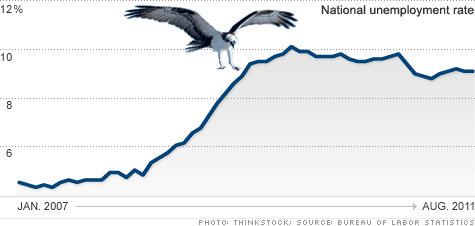Search News

As joblessness soars, so do the unemployment hawks.
NEW YORK (CNNMoney) -- Forget about inflation hawks. It's the unemployment hawks who are quietly winning the debate at the Federal Reserve.
The Fed's dual mandate to promote both maximum employment and price stability creates a natural conflict as policymakers debate the best action to stabilize the economy. But rarely in the central bank's history has that debate been so pronounced.
Three district bank presidents are vocal in their worries that the Fed will cause inflation by buying up Treasuries and pumping hundreds of billions into the economy.
They are one reason the central bank has avoided definitive action at the last few meetings. And with the latest Consumer Price Index showing the highest level of inflation in three years, inflation hawks are sure to start squawking again.
But they're likely to be overruled at this week's meeting, which concludes Wednesday when the Fed issues its closely-watched policy statement. As the job market remains flat, and the economy continues to slow, the central bank is expected to announce some kind of additional steps to address the slowing U.S. economy and stubbornly high unemployment rate.
The most vocal unemployment hawk has been Chicago Fed President Charles Evans, who said in a speech earlier this month that persistently high unemployment needs to be the central bank's focus right now.
He said that if inflation was several percentage points above the desired level the way unemployment has been for the last few years, Fed members "would be acting as if their hair was on fire. We should be similarly energized about improving conditions in the labor market."
And he's not the only one voicing support for more action.
San Francisco Fed President John Williams essentially dismissed the risk of inflation in a recent speech and argued the Fed's attention needs to be focused instead on jobs and weak growth. Though Williams is currently an alternate member of the Federal Open Market Committee, he will join the rate-setting panel next year.
"The real threat is an economy that is at risk of stalling and the prospect of many years of very high unemployment, with potentially long-run negative consequences," he said. "There are a number of potential steps the Fed could take to ease financial conditions further and move us closer to our mandated goals of maximum employment and price stability."
Among those steps is a third round of Treasury purchases, known as quantitative easing, or QE3, although most economists think the Fed will stop short of adding to an already bloated balance sheet.
But shifting the Fed's Treasury holdings from shorter-term to longer-term bonds, a policy known as "Operation Twist" is likely, according many economists, as is eliminating the interest paid to banks on their excess reserves.
Fed watchers say one of the things that will help unemployment hawks tip the scales is that they are backed by Fed Chairman Ben Bernanke, Vice Chairman Janet Yellen and New York Fed President William Dudley.
"Those three are ready to act, and they're able to take along the others in the center of the debate," said Paul Ashworth, chief U.S. economist for Capital Economics.
The problem for the unemployment hawks is it's not clear whether the steps they have available will have much impact on hiring.
"We have to be realistic. Short-term rates are at zero and long-term rates are at 60-year lows. We've got mortgage rates at record lows," said Bernard Baumohl of the Economic Outlook Group, a Princeton, N.J., research firm. "If that cheap credit is unable to stimulate growth, there is nothing more the Fed can do."
Ashworth says that's one reason the unemployment hawks aren't getting more attention -- no one really believes the steps they're advocating can make much of a difference.
"A modest drop in rates might help at margin, but it's not like long-term rates are high to start with," he said. "Basically there's not much they can do right now." ![]()
| Overnight Avg Rate | Latest | Change | Last Week |
|---|---|---|---|
| 30 yr fixed | 3.80% | 3.88% | |
| 15 yr fixed | 3.20% | 3.23% | |
| 5/1 ARM | 3.84% | 3.88% | |
| 30 yr refi | 3.82% | 3.93% | |
| 15 yr refi | 3.20% | 3.23% |
Today's featured rates:
| Latest Report | Next Update |
|---|---|
| Home prices | Aug 28 |
| Consumer confidence | Aug 28 |
| GDP | Aug 29 |
| Manufacturing (ISM) | Sept 4 |
| Jobs | Sept 7 |
| Inflation (CPI) | Sept 14 |
| Retail sales | Sept 14 |